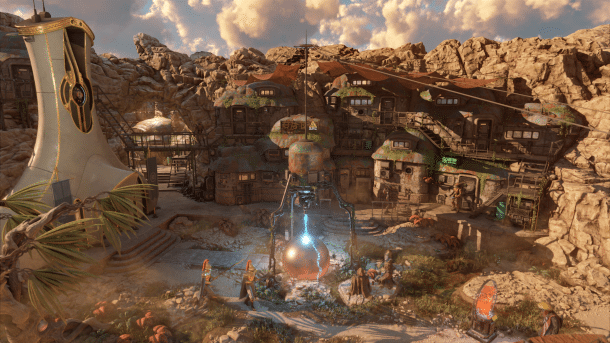3DMark Steel Nomad: Cross-platform graphics benchmark tested
The new 3D scene measures the performance of gaming PCs, tablets and smartphones under different operating systems. We have the first benchmark values.

Scene from the 3DMark Steel Nomad.
(Image: c't [Screenshot])
A new 3DMark benchmark is designed to compare the 3D performance of different systems more reliably. For over 25 years, the 3DMark benchmark has been measuring the 3D performance of graphics cards and integrated GPUs in numerous versions in order to compare them with each other. The Finnish software division of the testing organization Underwriters Laboratories (UL) developed the new 3D scene Steel Nomad for 3DMark, which was released in 2013. It is intended to replace the previous Time Spy and Time Spy Extreme partial evaluations, which are over seven years old and can no longer properly reflect the performance of modern high-end graphics cards.
Videos by heise
Steel Nomad exclusively uses raster graphics without ray tracing graphic effects, which only selected game titles have used to date due to the high hardware requirements. In order to be able to compare different devices and platforms, the scene runs on Windows and Windows-on-Arm. A macOS version is also planned for this year and Steel Nomad will also be available for Android, iOS and Linux in the future. The demanding 3D scene is designed to utilize high-end graphics cards and therefore requires at least 8 GB of system memory and 8 GB of graphics memory under Windows. Computers with graphics integrated in the processor require 16 GB of RAM because the CPU and iGPU share the RAM.
(Image: c't [Screenshot])
Light version also for Android and iOS
For weaker hardware such as laptops and mini PCs with iGPU as well as smartphones and tablets, UL is offering the slimmed-down Steel Nomad Light version. This will be available for download tomorrow (Tuesday, June 21, 2024) not only for Windows (ARM + x86) but also for the Android and iOS versions of 3DMark. A version adapted for macOS is set to follow later this year, but the iOS app will also run on Macs with Apple M1 and newer. UL is also working on a Linux version. Compared to Steel Nomad, the light version on Windows requires half the video memory of 4 GB, but also requires at least 8 GB of installed RAM.
Different 3D interfaces are used depending on the operating system: Steel Nomad (Light) uses Microsoft's DirectX 12 and the OpenGL successor Vulkan on Windows, Apple Metal on macOS and iOS and Vulkan on Android and Linux.
Empfohlener redaktioneller Inhalt
Mit Ihrer Zustimmung wird hier ein externer Inhalt geladen.
Ich bin damit einverstanden, dass mir externe Inhalte angezeigt werden. Damit können personenbezogene Daten an Drittplattformen übermittelt werden. Mehr dazu in unserer Datenschutzerklärung.
First benchmarks
We were able to carry out independent tests in Steel Nomad and Steel Nomad Light with a pre-release version. The benchmark runs at over 60 fps on powerful graphics cards such as the GeForce RTX 4080 Super, while the frame rate drops to under 15 fps on inexpensive 200-euro cards such as the Radeon RX 6600. The score is calculated from the average frame rate × 100, meaning that a GeForce RTX 4080 Super achieves 6630 points.
The less demanding Light variant not only offers higher frame rates, but also a different scoring metric. Here, the score is calculated from 135 times the average frame rate over the scene. For example, a Radeon RX 6600 with 52.35 fps on average achieves 7067 points.
Steel Nomad and Steel Nomad Light are available as a free update for all 3DMark editions, even for users of the free version.
(chh)